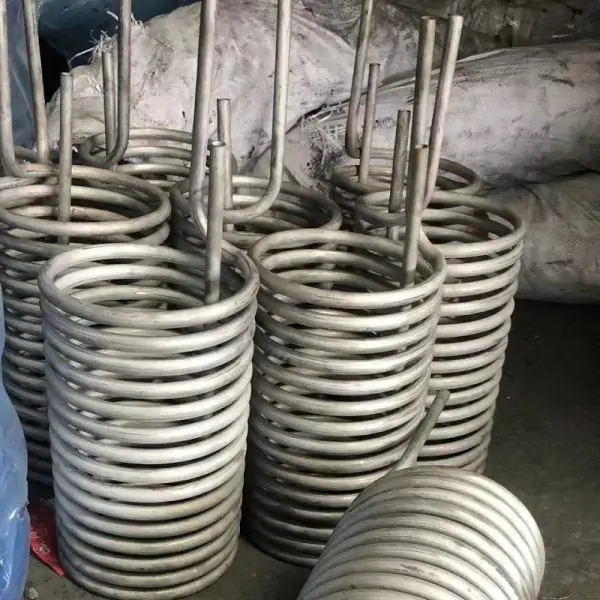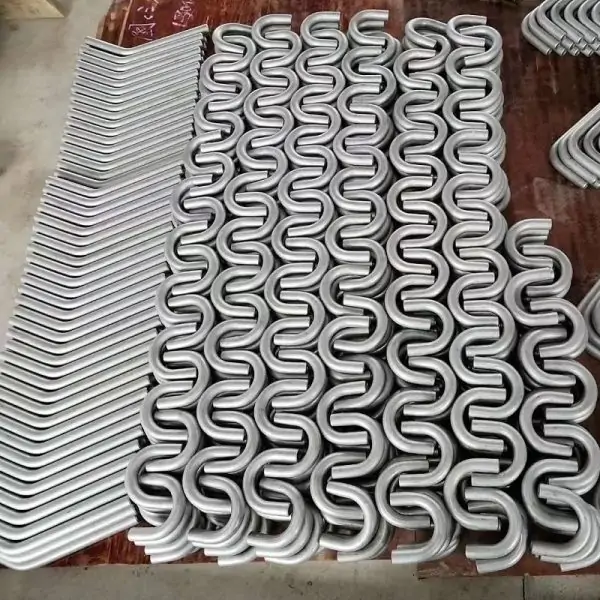I. Introducción
El curvado de tubos de acero inoxidable es un proceso de fabricación utilizado para dar a los tubos de acero inoxidable diversas formas, como curvas, ángulos o formas complejas, para cumplir requisitos de diseño específicos. Este proceso es esencial en industrias como la automoción, la aeroespacial, la construcción y la fabricación de muebles, donde los tubos de acero inoxidable se utilizan ampliamente por su durabilidad, resistencia a la corrosión y atractivo estético.
Comprender el proceso de curvado es crucial para las industrias que dependen de los tubos de acero inoxidable, ya que garantiza la producción de componentes de alta calidad que cumplen las especificaciones exactas. Ya sea para crear componentes estructurales, sistemas de escape o elementos decorativos, saber cómo doblar tubos de acero inoxidable correctamente puede resultar en una producción rentable, una mayor eficiencia y productos finales superiores.

II. Fundamentos de los tubos de acero inoxidable
El acero inoxidable es una aleación de acero que contiene cromo, lo que le confiere resistencia a la corrosión y solidez. Se utiliza habitualmente en varias industrias por su durabilidad, resistencia a altas temperaturas y atractivo estético. Cuando se trata de doblar tubos de acero inoxidable, es fundamental conocer las propiedades del material para conseguir los resultados deseados.
Existen varios tipos de tubos de acero inoxidable utilizados habitualmente en curvado, entre ellos:
-
Acero inoxidable austenítico: Este tipo de acero inoxidable es el más común y ofrece buena conformabilidad y soldabilidad. Suele utilizarse en aplicaciones que requieren una alta resistencia a la corrosión.
-
Acero inoxidable ferrítico: El acero inoxidable ferrítico es magnético y ofrece una buena resistencia a la corrosión en determinados entornos. Sin embargo, es menos conformable que el acero inoxidable austenítico.
-
Acero inoxidable martensítico: El acero inoxidable martensítico es fuerte y duro, pero tiene menor resistencia a la corrosión que los aceros inoxidables austeníticos y ferríticos. Suele utilizarse en aplicaciones en las que la resistencia y la dureza son importantes.
-
Acero inoxidable dúplex: El acero inoxidable dúplex ofrece una combinación de alta resistencia y buena resistencia a la corrosión. Suele utilizarse en aplicaciones en las que se requieren ambas propiedades.
Comprender las propiedades de estos tipos de acero inoxidable es esencial para seleccionar el material adecuado para las aplicaciones de plegado y garantizar que el proceso de plegado se lleve a cabo con eficacia.
III. Equipamiento y herramientas
El curvado de tubos de acero inoxidable requiere equipos y herramientas especializados para garantizar la precisión y calidad del proceso de curvado. A continuación se enumeran los componentes clave utilizados en el curvado de tubos de acero inoxidable:
- Máquina curvadora de tubos: Es el principal equipo utilizado para curvar tubos de acero inoxidable. Existen distintos tipos de máquinas curvadoras de tubos: manuales, semiautomáticas y totalmente automáticas. Estas máquinas utilizan diversos métodos, como el curvado por estirado rotativo, el curvado con mandril o el curvado por compresión, para conseguir el radio y el ángulo de curvatura deseados.
- Mandriles: Los mandriles se utilizan para sujetar la superficie interior del tubo durante el curvado, evitando que se arrugue o colapse. Los hay de diferentes formas y tamaños para adaptarse a distintos diámetros de tubo y requisitos de curvado.
- Muere: Las matrices se utilizan para formar el tubo alrededor del radio de curvatura. Están disponibles en varios tamaños y formas para crear diferentes ángulos y radios de curvatura.
- Troqueles de limpiaparabrisas: Las matrices limpiadoras se utilizan para evitar las arrugas y garantizar una superficie de curvado lisa. Se colocan detrás de la matriz de doblado y ayudan a mantener la forma del tubo durante el doblado.
- Mordazas: Las matrices de sujeción se utilizan para mantener el tubo en su sitio durante el curvado. Garantizan que el tubo no se mueva ni se deforme durante el proceso de curvado.
- Sistema de lubricación: Se utiliza un sistema de lubricación para reducir la fricción entre el tubo y los componentes de la curvadora, lo que garantiza un curvado suave y evita daños en el tubo.
Seleccionar el equipo y las herramientas adecuadas para el curvado de tubos de acero inoxidable es crucial para conseguir curvados precisos y de alta calidad. A la hora de seleccionar el equipo, es importante tener en cuenta factores como el material del tubo, el radio y el ángulo de curvatura deseados y el volumen de producción. El uso de equipos y herramientas de alta calidad puede ayudar a mejorar la eficacia, reducir los residuos y garantizar una calidad de curvado constante.

IV. Etapas del proceso
El curvado de tubos de acero inoxidable implica varios pasos clave para garantizar el correcto curvado del tubo y la calidad del producto final:
-
Preparación del tubo: El proceso comienza con la preparación del tubo de acero inoxidable para el curvado. Esto incluye cortar el tubo a la longitud necesaria y desbarbar los bordes para eliminar cualquier arista afilada o irregular que pudiera afectar al proceso de curvado.
-
Selección del método de curvado: A continuación, se selecciona el método de curvado adecuado en función de las especificaciones del proyecto y del radio y ángulo de curvatura deseados. Los métodos de curvado habituales para tubos de acero inoxidable son el curvado con mandril, el curvado con prensa y el curvado por estirado rotativo.
-
Proceso de plegado: A continuación, el tubo se coloca en la máquina curvadora y se lleva a cabo el proceso de curvado. En el curvado con mandril, se inserta un mandril en el tubo para sujetar la pared interior y evitar que se hunda o se arrugue. El curvado con prensa utiliza una prensa para curvar el tubo alrededor de una matriz, mientras que el curvado con estirado rotativo utiliza una matriz giratoria para curvar el tubo.
-
Aplicación de calor (si es necesario): En algunos casos, puede aplicarse calor al tubo durante el proceso de doblado para hacerlo más maleable y fácil de doblar. El calor puede ayudar a reducir el riesgo de grietas u otros defectos en el curvado.
-
Medidas de control de calidad: A lo largo del proceso de doblado, se aplican medidas de control de calidad para garantizar la precisión y consistencia de los doblados. Esto puede incluir la supervisión del ángulo y el radio de curvatura, la inspección del tubo en busca de defectos y la realización de los ajustes necesarios para mantener los estándares de calidad.
Siguiendo estos pasos del proceso, los fabricantes pueden garantizar el curvado preciso de los tubos de acero inoxidable y la fabricación de productos de alta calidad que cumplan las especificaciones requeridas.
V. Factores que afectan a la flexión
-
Consideraciones materiales: La calidad y el grosor del tubo de acero inoxidable influyen considerablemente en el proceso de doblado. Los tubos de mayor calidad y grosor requieren más fuerza y pueden ser más propensos a agrietarse o deformarse durante el curvado.
-
Geometría y dimensiones del tubo: El diámetro, el grosor de la pared y la geometría general del tubo influyen en el proceso de curvado. Los tubos con diámetros más pequeños o paredes más finas suelen ser más fáciles de doblar que los tubos más grandes o gruesos.
-
Requisitos de radio y ángulo de curvatura: El radio y el ángulo de curvatura deseados determinan el método de curvado y la maquinaria necesaria. Las curvas cerradas o los radios estrechos pueden requerir equipos especializados o el curvado con mandril para evitar la distorsión del tubo.
-
Efectos de la temperatura y la presión en la flexión: En algunos casos, puede aplicarse calor al tubo durante el doblado para reducir su rigidez y mejorar su conformabilidad. Sin embargo, un exceso de calor puede debilitar el acero inoxidable y afectar a su resistencia a la corrosión. También puede aplicarse presión para ayudar a dar forma al tubo, pero hay que tener cuidado de no sobrecargar el material.
Comprender estos factores es crucial para conseguir la calidad de curvado deseada y evitar defectos como grietas, arrugas o springback. Si se tienen en cuenta cuidadosamente estos factores, los fabricantes pueden garantizar el éxito del curvado de tubos de acero inoxidable para diversas aplicaciones industriales.
VI. Precauciones de seguridad
- Importancia de una formación y certificación adecuadas: Es fundamental que los operarios reciban la formación y certificación adecuadas antes de dedicarse al curvado de tubos de acero inoxidable. Esta formación garantiza que entienden el equipo, el proceso de doblado y los protocolos de seguridad, reduciendo el riesgo de accidentes o lesiones.
- Utilización de equipos de protección individual (EPI): Los operarios deben llevar el EPI adecuado, incluidas gafas de seguridad, guantes y protección auditiva, para protegerse de peligros potenciales como la proyección de residuos, el ruido y el calor durante el proceso de plegado. Además, garantizar un espacio de trabajo bien ventilado puede ayudar a mitigar la exposición a humos o gases producidos durante el plegado.
VII. Aplicaciones del curvado de tubos de acero inoxidable
- Ejemplos de industrias y productos: El curvado de tubos de acero inoxidable es esencial en sectores como la automoción, la industria aeroespacial, la construcción y la fabricación. Se utiliza para crear componentes para sistemas de escape, pasamanos, sistemas hidráulicos y armazones estructurales, entre otros.
- Ventajas del acero inoxidable: El acero inoxidable ofrece varias ventajas en las aplicaciones de plegado. Es muy resistente a la corrosión, por lo que resulta adecuado para exteriores y entornos difíciles. El acero inoxidable también es duradero, con una elevada relación resistencia-peso, y soporta altas temperaturas y presiones, por lo que es ideal para una amplia gama de aplicaciones.
VIII. Conclusión
El curvado de tubos de acero inoxidable es un proceso de fabricación crucial que se utiliza en varias industrias para dar la forma deseada a los tubos de acero inoxidable. Comprender las propiedades del acero inoxidable y el proceso de curvado es esencial para conseguir curvados de alta calidad. El proceso implica preparar el tubo, seleccionar el método de doblado y garantizar el control de calidad en todo momento. Factores como el grado del material, la geometría del tubo y el radio de curvatura afectan al proceso de curvado y requieren una cuidadosa consideración. Las precauciones de seguridad, incluida la formación adecuada y el uso de EPI, son vitales para evitar accidentes.
El curvado de tubos de acero inoxidable tiene aplicaciones en los sectores de automoción, aeroespacial y construcción, gracias a la resistencia a la corrosión y durabilidad del acero inoxidable. A medida que avanza la tecnología, las tendencias futuras pueden centrarse en mejorar la precisión, la eficacia y la automatización del proceso de curvado.
